Mastered by the Greene brothers, whose landmark Gamble House still stands as a masterpiece of the ideals that the Craftsman style promoted, the fashion translated to all scales of home building. These houses became extraordinarily popular throughout the U.S. during the first 30 years of the 20th century. Pattern books and periodicals furthered the study of the architecture; even kits to build an entire house could be ordered and delivered to building sites.
Other revivals — and midcentury modern architecture, including ranch — replaced the Craftsman style after the 1920s. Its own revival, among revivals of many other types, blossomed in the late 20th century and continues today. The range of configurations probably contributes to the adaptability of this architecture to newer houses.
Originals can be found in four primary roof shapes: front gabled, cross gabled, side gabled and hipped roof. The details of the porch posts and rails, rafter tails and eave brackets allow significant variation. Also, brick, stone, stucco and wood siding of many different types is used in this style, resulting in almost every example's taking on its own unique identity.
Sarah Greenman
Front-Gabled Craftsman Homes
This Seattle house has a full-width porch stretching from one outside end post to the other. The square posts rest atop brick piers that rise to a height just slightly above the porch railing. Many variations of the post and pier are found on Craftsman houses, as illustrated in the following examples. Decorative brackets typically support the barge board, as seen here. A triple attic window underscored with a bracketed flower box adorns the broad gable face here also.
Notice the transom section above the lower-level windows, which is another common Craftsman detail. Dark gray paint unifies the clapboard and stucco exterior wall finishes on this house.
This Seattle house has a full-width porch stretching from one outside end post to the other. The square posts rest atop brick piers that rise to a height just slightly above the porch railing. Many variations of the post and pier are found on Craftsman houses, as illustrated in the following examples. Decorative brackets typically support the barge board, as seen here. A triple attic window underscored with a bracketed flower box adorns the broad gable face here also.
Notice the transom section above the lower-level windows, which is another common Craftsman detail. Dark gray paint unifies the clapboard and stucco exterior wall finishes on this house.
Historical Concepts
Another front-gabled example, this one in Atlanta, has its own defining characteristics. Here three square posts resting on brick piers support the porch roof. Knee braces support the barge board brackets. As in the previous example, the body of the house is clapboard, but this gable face is shingled. As in almost all Craftsman houses, the rafter tails are exposed, as opposed to being enclosed within a soffit.
Brooks Ballard
This newer Craftsman revival house employs gable end details similar to the previous two examples, but tapered porch supports rest on square brick piers here. Distinctive to this style, tapered posts on some originals may be of wood or stone. Notice that the brick extends to form the porch railing and that the right end of the porch appears as an enclosed portion, which is nicely detailed with multipane windows.
The staggered shingles reflect the texture of the mixed brick. Look closely to see a combination of red and weathered blocks. Once again clapboard siding surrounds the main body of the house.
The staggered shingles reflect the texture of the mixed brick. Look closely to see a combination of red and weathered blocks. Once again clapboard siding surrounds the main body of the house.
Paul Moon Design
In another revival in the U.S. Northwest, a double gable defines the front view, a configuration found in some originals. The smaller gable establishes the entrance porch and is detailed with the same knee brace brackets as the dominant gable.
Consider that the entrance steps rise to a few feet above the finished landscape. Craftsman houses are normally built upon crawlspace foundations or basements. In the decades following the original Craftsman era, slab foundations came into common use across California and many of the warmer U.S. climates. This important trait can be lost when Craftsman details are applied to ranch-style houses. By nature, Craftsman homes want to stand up straight and be vertical, as opposed to flowing over the landscape as ranch designs do.
Consider that the entrance steps rise to a few feet above the finished landscape. Craftsman houses are normally built upon crawlspace foundations or basements. In the decades following the original Craftsman era, slab foundations came into common use across California and many of the warmer U.S. climates. This important trait can be lost when Craftsman details are applied to ranch-style houses. By nature, Craftsman homes want to stand up straight and be vertical, as opposed to flowing over the landscape as ranch designs do.
First Lamp
Great effort was taken to establish the identity of this two-story front-gabled Craftsman revival house in the Seattle area. Shingled piers taper to hold a thinner, short, square column, and a simple railing encloses the porch. The attenuated rafter tails add personality, while the oversize knee brackets painted the same bright white provide high contrast to the large body of the house.
Notice the mixture of clapboard and shingle siding. The shingle provides emphasis at the projections, gabled ends and post piers. Handsome double-hung windows are multipane on top and single pane on the lower, which is another original Craftsman trait.
Notice the mixture of clapboard and shingle siding. The shingle provides emphasis at the projections, gabled ends and post piers. Handsome double-hung windows are multipane on top and single pane on the lower, which is another original Craftsman trait.
Bennett Frank McCarthy Architects, Inc.
Cross-Gabled Craftsman Homes
A second type of Craftsman features a primary side-gabled roof fronted with another significant gable that can extend to cover porches and other rooms or comprise a second level.
This designer of this Washington, D.C.–area remodel grabbed the Craftsman theme and transformed a basic cottage into a delightful abode full of character. Notice that the gable front becomes a screen to the ceiling of the porch, where a fan dangles to provide airflow. The exquisite detail of the gable and railing highly respects the roots of Craftsman architecture.
Also delightful here are the slanted brackets atop the tapered columns. Hefty square piers confidently support those columns and the porch roof. Clapboard siding combines with detailed roof shingles to confirm the personality of this house.
A second type of Craftsman features a primary side-gabled roof fronted with another significant gable that can extend to cover porches and other rooms or comprise a second level.
This designer of this Washington, D.C.–area remodel grabbed the Craftsman theme and transformed a basic cottage into a delightful abode full of character. Notice that the gable front becomes a screen to the ceiling of the porch, where a fan dangles to provide airflow. The exquisite detail of the gable and railing highly respects the roots of Craftsman architecture.
Also delightful here are the slanted brackets atop the tapered columns. Hefty square piers confidently support those columns and the porch roof. Clapboard siding combines with detailed roof shingles to confirm the personality of this house.
stirling group inc
This original Charlotte, North Carolina, Craftsman house got a second floor in its remodel. A double front gable with a cross side gable over a porch defines the original structure. The new second level rises at a comfortable distance behind. A smaller front-facing gable breaks down the side gable of the new upper floor. Shingles cover the entire house. The segmented and minimized scale of the second-level addition successfully complements the original configuration.
Asher Associates Architects
This shingled Philadelphia-area house shows how varied Craftsman style can be. The prominent front and side gables give it tremendous presence, and the unique hipped porch roof holds a small balcony.
Notice the variation of the columns compared to the previous houses shown. The pier has been eliminated in favor of large, square, full-height tapered posts. The porch header curves abruptly as it meets the columns, softening that transition. A double window at the gable peak indicates a third-floor attic space. Also notice that this elevation is symmetrical, as opposed to the previous examples. Few styles function well in both symmetrical and asymmetrical configurations.
Notice the variation of the columns compared to the previous houses shown. The pier has been eliminated in favor of large, square, full-height tapered posts. The porch header curves abruptly as it meets the columns, softening that transition. A double window at the gable peak indicates a third-floor attic space. Also notice that this elevation is symmetrical, as opposed to the previous examples. Few styles function well in both symmetrical and asymmetrical configurations.
Dennis Mayer - Photographer
Whimsical details emphasized with highly contrasting colors adorn his house in the San Francisco area. Elaborately carved barge boards in the spirit of a Swiss chalet delicately play to its charm. Some California examples can be called the Western Stick style for the use of the trim detail in gable faces such as these. Notice the unusual combination of the hip roof above right, and as a belt line around the lower left, which provides a roof for the bay window.
Tim Andersen Architect
Side-Gabled Craftsman Homes
A primary side-gabled roof is a very popular configuration. Frequently, substantial dormers hold a second level. This results in a more intimately scaled two-story design. Second-level porches are rarer, however, and can complement the design and detail, as does the railing on this original Seattle example.
A primary side-gabled roof is a very popular configuration. Frequently, substantial dormers hold a second level. This results in a more intimately scaled two-story design. Second-level porches are rarer, however, and can complement the design and detail, as does the railing on this original Seattle example.
WINN Design+Build
As I mentioned earlier, you could once order a kit (in this case from Sears) and have the entire house sent to your site for assembly. And you thought Ikea was complex!
Joking aside, buyers of kit homes could take on the construction themselves or employ contractors to build them. Most were built near railroad depots, as by train was normally the method of shipment. Notice here how the details are simpler in comparison to the other examples. The form and overall impression maintain the Craftsman character.
Joking aside, buyers of kit homes could take on the construction themselves or employ contractors to build them. Most were built near railroad depots, as by train was normally the method of shipment. Notice here how the details are simpler in comparison to the other examples. The form and overall impression maintain the Craftsman character.
Evens Architects
Returning to the native soil of the Craftsman house, this Los Angeles–area house has been lovingly remodeled and updated. Notice the unique window mullions, which loosely resemble Prairie details. Prairie style had some influence over this one, as it was also popular in the early 20th century. Double square columns comprise the porch supports (difficult to see in this photo), yet another variation in the style.
Brooks Ballard
A side gable with a gable dormer defines this Craftsman revival. Successful proportions help disguise the age of this house. Tapered columns top brick piers, faithfully matching original examples. Notice the clapboard siding combined with the vertical detail in the gable face, an element found in the Western Stick style.
Brooks Ballard
Hipped-Roof Craftsman Homes
Hipped-roof Craftsman houses were were less numerous, but many similar foursquare-style houses exist across the U.S. To find the difference, look for Craftsman attributes such as the double porch column on this revival. Eaves can, but would rarely, be boxed in with soffits, as in this example. Brick piers provide further definition of this home's style. Notice how those piers break the line of the porch floor, which you can see in most of the houses presented here.
Hipped-roof Craftsman houses were were less numerous, but many similar foursquare-style houses exist across the U.S. To find the difference, look for Craftsman attributes such as the double porch column on this revival. Eaves can, but would rarely, be boxed in with soffits, as in this example. Brick piers provide further definition of this home's style. Notice how those piers break the line of the porch floor, which you can see in most of the houses presented here.
Brooks Ballard
Leaning toward the foursquare identity, this new Craftsman revival exhibits the tapered upper column common to the style. Stone-covered piers characteristically break the floor line of the porch. A nicely detailed belt line divides a lower floor with clapboard siding from the shingled upper floor. Notice the hipped porch roof and the unusual segmented arch set in a secondary gable above the porch steps. A hipped dormer at the attic level caps the theme.
Tavan Group
Eclectic Craftsman Homes
This enchanting Vancouver house borrows from American Tudor for its half-timbered applique, as well as the Shingle style for the eyebrow dormer and medieval massing. Regardless, the Craftsman theme is carried out through exposed rafter tails, shingle and stucco siding, and a prominent porch with tapered columns set atop stone piers.
This enchanting Vancouver house borrows from American Tudor for its half-timbered applique, as well as the Shingle style for the eyebrow dormer and medieval massing. Regardless, the Craftsman theme is carried out through exposed rafter tails, shingle and stucco siding, and a prominent porch with tapered columns set atop stone piers.
Michael Kelley Photography
Last we return to Southern California to visit another eclectic Craftsman example. In the spirit of Spanish eclectic, a confident, smoothly stuccoed lower elevation with Roman arches supports a smartly detailed upper level painted in a highly contrasting chocolate brown.
Sage-green window trim softly complements the color scheme and helps unify the composition. On the roof areas we find a beam bracket, without braces, supporting the rakes of the gables, which is another detail found in some originals. Beam projections appear beneath the flared walls of the upper level to provide visual support.
More: Wallpaper Kicks Up a Century-Old Craftsman
Sage-green window trim softly complements the color scheme and helps unify the composition. On the roof areas we find a beam bracket, without braces, supporting the rakes of the gables, which is another detail found in some originals. Beam projections appear beneath the flared walls of the upper level to provide visual support.
More: Wallpaper Kicks Up a Century-Old Craftsman
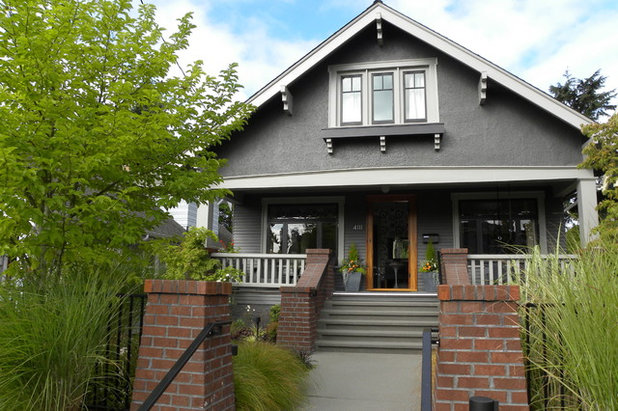
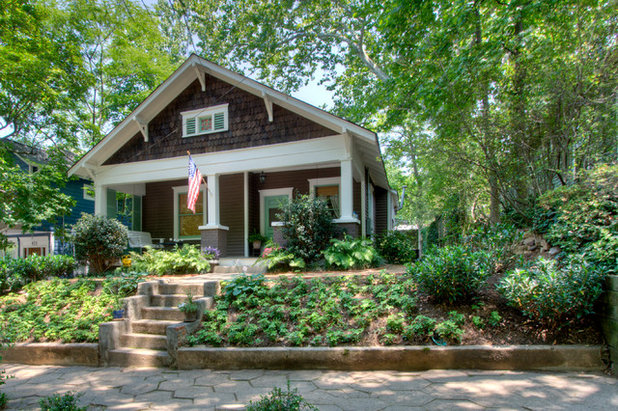
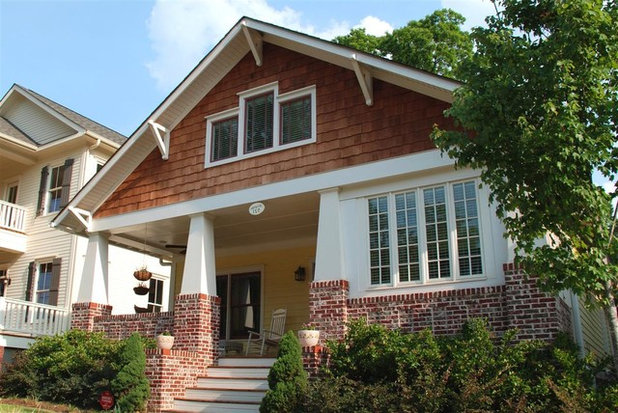
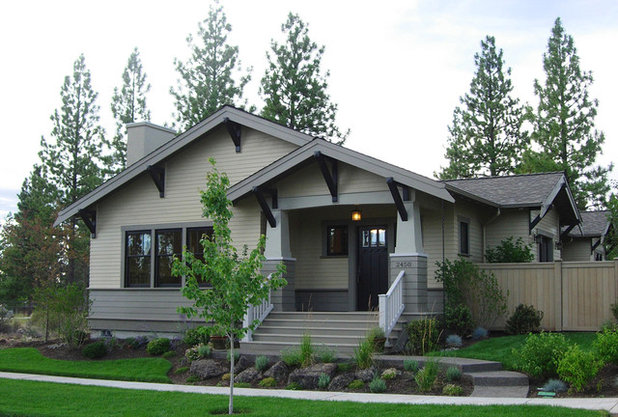
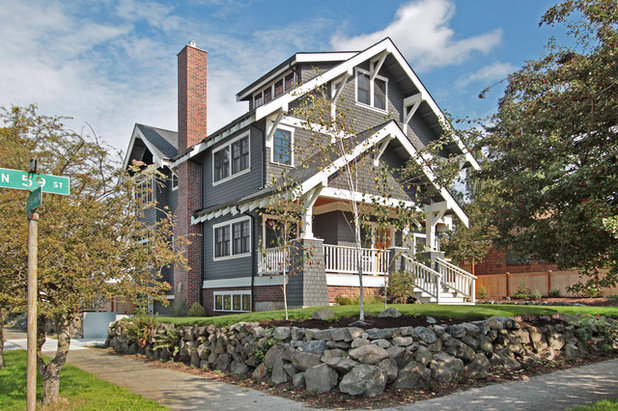
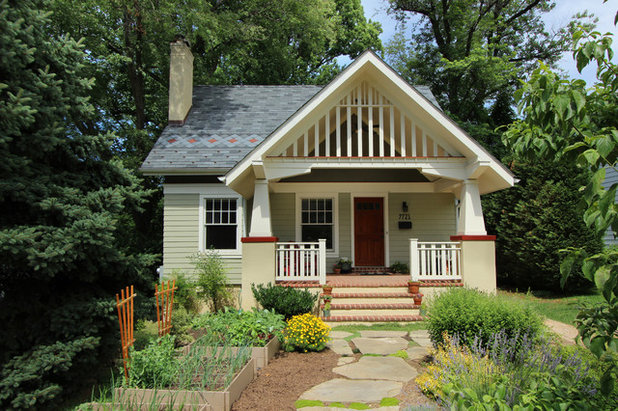
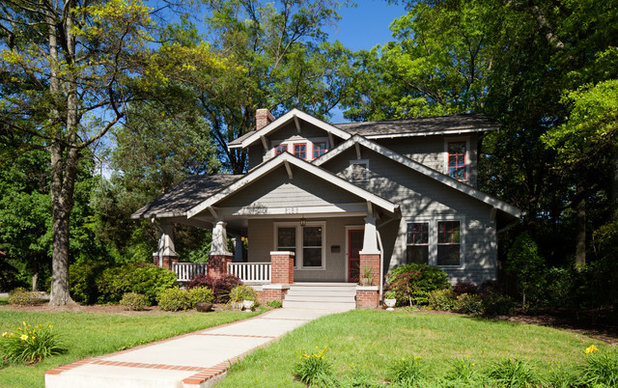
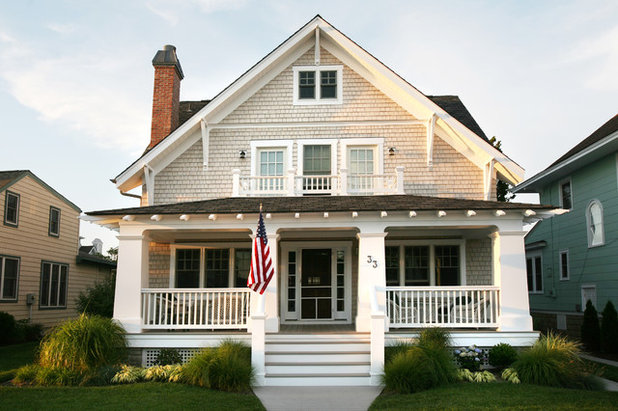
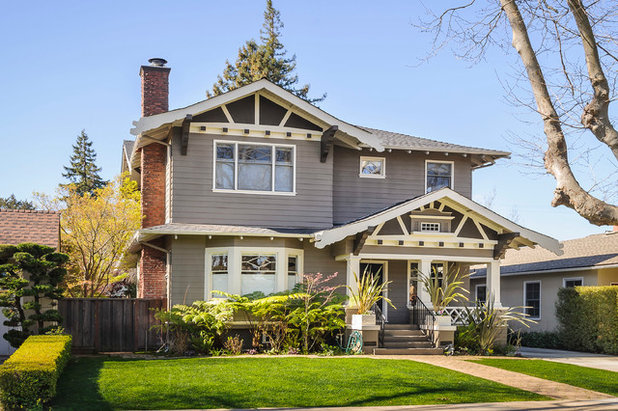
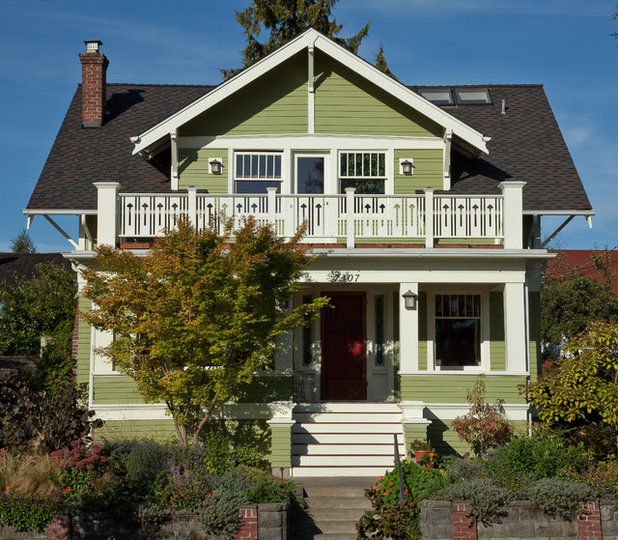
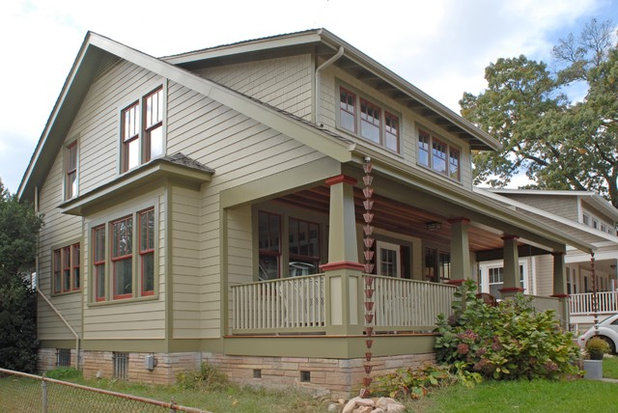
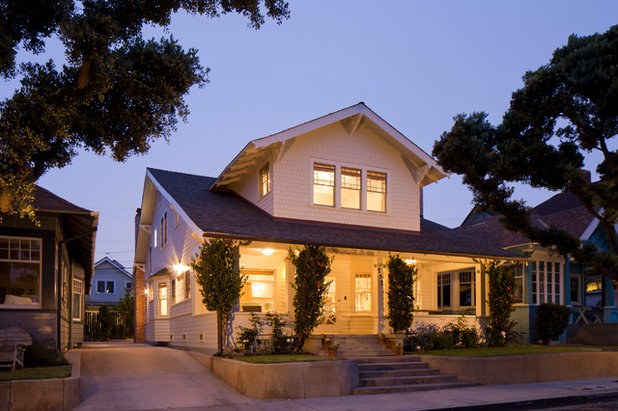
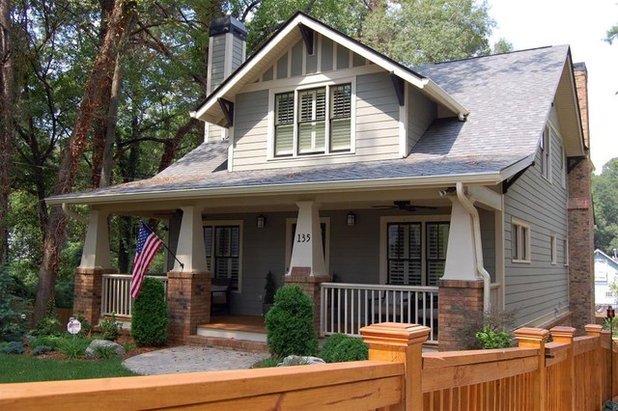
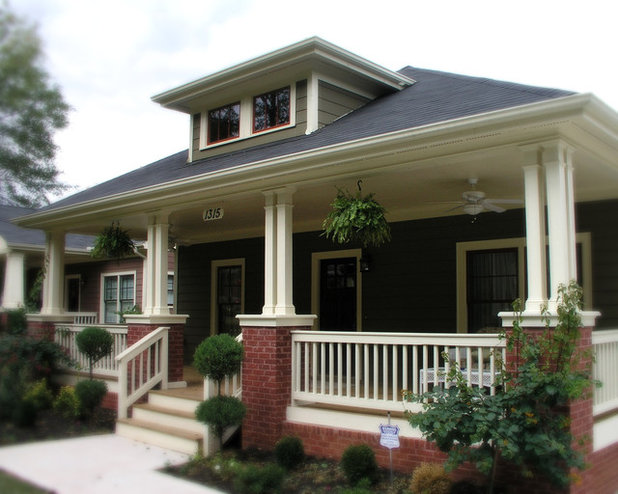
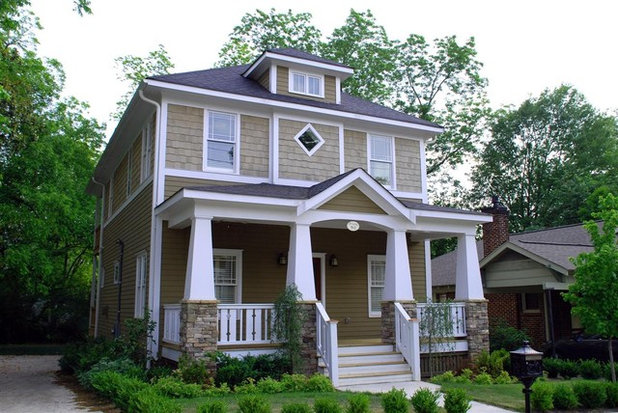
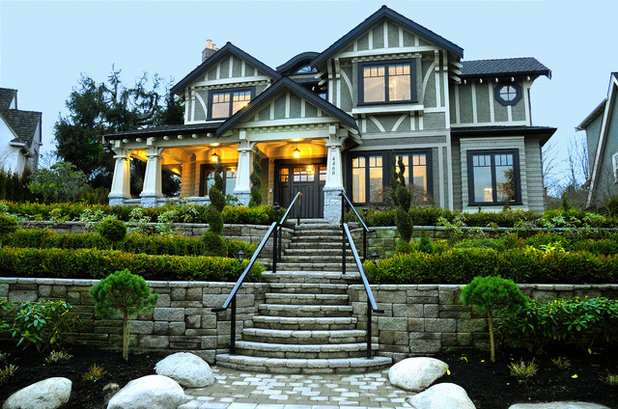
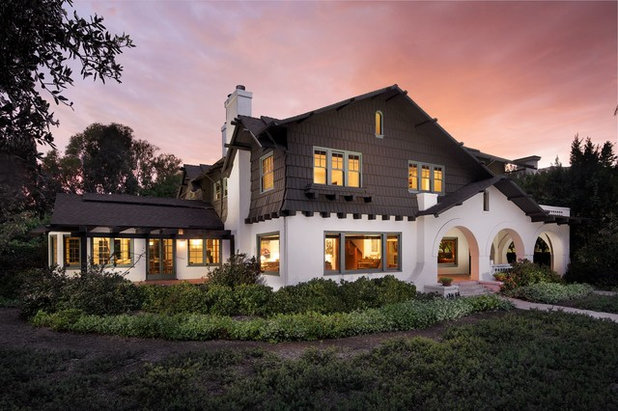
0 comments:
Post a Comment